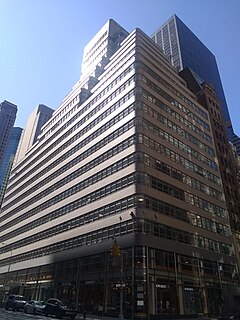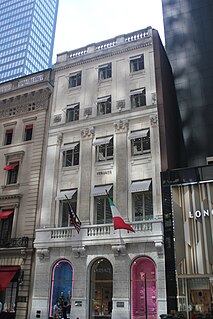
Lever House is a glass-box skyscraper at 390 Park Avenue in the Midtown Manhattan neighborhood of New York City. The building was designed in the International Style by Gordon Bunshaft and Natalie de Blois of Skidmore, Owings & Merrill (SOM) as the headquarters of soap company Lever Brothers, a subsidiary of Unilever. Constructed from 1950 to 1952, it was the second curtain wall skyscraper in New York City after the United Nations Secretariat Building.

550 Madison Avenue is a postmodern skyscraper at Madison Avenue between 55th and 56th Streets in the Midtown Manhattan neighborhood of New York City. Designed by Philip Johnson and John Burgee with associate architect Simmons Architects, the building was completed in 1984 as the headquarters of AT&T and later became the American headquarters of Sony. The building consists of a 647-foot-tall (197-meter), 37-story office tower with a facade made of pink granite. It originally had a four-story granite annex to the west, which was demolished and replaced with a shorter annex in 2020.

3 East 57th Street, originally the L. P. Hollander Company Building, is a nine-story commercial building in the Midtown Manhattan neighborhood of New York City. It is along the northern side of 57th Street, just east of Fifth Avenue. 3 East 57th Street, constructed from 1929 to 1930, was designed by Shreve, Lamb & Harmon in an early Art Deco style.

Church Missions House is a historic building at Park Avenue South and East 22nd Street in the Gramercy Park neighborhood of Manhattan in New York City, in an area once known as "Charity Row". The building was designed by Robert W. Gibson and Edward J. Neville Stent, with a steel structure and Medieval-inspired facade. The design was inspired by the town halls of Haarlem and Medieval Amsterdam. Church Missions House is so named because it was the headquarters of the Episcopal Church's Domestic and Foreign Missionary Society for much of the 20th century.

The Cartier Building, also 653 Fifth Avenue, is a commercial building on the southeast corner of 52nd Street and Fifth Avenue in the Midtown Manhattan neighborhood of New York City. The building serves as the flagship store of Cartier in New York City. It consists of two conjoined residences completed in 1905: the Morton F. Plant residence at 651–653 Fifth Avenue, designed by Robert W. Gibson, and the Edward Holbrook residence at 4 East 52nd Street, designed by C. P. H. Gilbert.

The William H. Moore House, also known as the Stokes-Moore Mansion and 4 East 54th Street, is a commercial building in the Midtown Manhattan neighborhood of New York City. It is along 54th Street's southern sidewalk between Madison Avenue and Fifth Avenue. The building was designed by McKim, Mead & White and constructed between 1898 and 1900 as a private residence.

The Ritz Tower is a luxury residential building at 465 Park Avenue on the corner of East 57th Street in the Midtown Manhattan neighborhood of New York City. It was built from 1925 to 1926 as an apartment hotel and was designed by Emery Roth and Thomas Hastings for journalist Arthur Brisbane, who was the developer. The Ritz Tower is about 541 feet (165 m) with 41 stories, making it the tallest residential building in New York City upon its completion. Because it was initially classified as an apartment hotel, the building was constructed to a greater height than was usually permitted.

224 West 57th Street, also known as the Argonaut Building and formerly as the Demarest and Peerless Company Building, is a commercial building on the southeast corner of Broadway and 57th Street in Midtown Manhattan, New York City, just south of Columbus Circle. The building consists of two formerly separate structures, the A. T. Demarest & Company Building and the Peerless Motor Car Company Building, both used by automobile companies. Both structures were designed by Francis H. Kimball and erected by the George A. Fuller Company with similar Gothic Revival and Romanesque Revival architectural details.

220 West 57th Street is a building on 57th Street in Midtown Manhattan in New York City. It was designed by Cyrus L. W. Eidlitz in the French Renaissance Revival style, with an annex built to designs by Eidlitz and Andrew C. McKenzie. The building served as the headquarters of the American Society of Civil Engineers (ASCE) from 1897 to 1917.
18 East 50th Street, also known as the Hampton Shops Building and the New York Health & Racquet Club Building, is an office building in the Midtown Manhattan neighborhood of New York City. Located on the south side of 50th Street, on the middle of the block between Fifth Avenue and Madison Avenue, it was designed by William Lawrence Rouse, Lafayette Anthony Goldstone, and Joseph L. Steinam.

488 Madison Avenue, also known as the Look Building, is a 25-story office building in the Midtown Manhattan neighborhood of New York City. It is along Madison Avenue's western sidewalk between 51st and 52nd Streets, near St. Patrick's Cathedral. 488 Madison Avenue was designed by Emery Roth & Sons in the International Style, and it was constructed and developed by Uris Brothers. The building was originally named for its primary tenant, the American magazine Look.

312 and 314 East 53rd Street are two wooden row houses on 53rd Street, between First Avenue and Second Avenue, in the Turtle Bay neighborhood of Manhattan in New York City. The row houses were designed by Robert and James Cunningham with French Second Empire and Italianate details. The houses are two of seven remaining wooden houses on the East Side of Manhattan north of 23rd Street.

689 Fifth Avenue is a commercial building in the Midtown Manhattan neighborhood of New York City, at the northeast corner of Fifth Avenue and 54th Street. The building was designed by Warren and Wetmore and constructed from 1925 to 1927.

5 West 54th Street is a commercial building in the Midtown Manhattan neighborhood of New York City. It is along 54th Street's northern sidewalk between Fifth Avenue and Sixth Avenue. The four-story building was designed by R. H. Robertson in the Italian Renaissance Revival style and was constructed between 1897 and 1899 as a private residence. It is the easternmost of five consecutive townhouses erected along the same city block during the 1890s, the others being 7, 11, 13 and 15 West 54th Street. The first floor is clad with rusticated blocks of limestone, while the other floors contain buff-colored brick trimmed with limestone.

The Rockefeller Apartments is a residential building at 17 West 54th Street and 24 West 55th Street in the Midtown Manhattan neighborhood of New York City. Designed by Wallace Harrison and J. André Fouilhoux in the International Style, the Rockefeller Apartments was constructed between 1935 and 1936. The complex was originally designed with 138 apartments.

12 West 56th Street is a consular building in the Midtown Manhattan neighborhood of New York City, housing the Consulate General of Argentina in New York City. It is along 56th Street's southern sidewalk between Fifth Avenue and Sixth Avenue. The four-and-a-half story building was designed by McKim, Mead & White in the Georgian Revival style. It was constructed between 1899 and 1901 as a private residence, one of several on 56th Street's "Bankers' Row".

46 West 55th Street is a commercial building in the Midtown Manhattan neighborhood of New York City. It is along the south side of 55th Street between Fifth Avenue and Sixth Avenue. The five-story building was designed by Thomas Thomas in the Italianate style and was constructed in 1869. It was redesigned in the neoclassical style between 1903 and 1904 by Edward L. Tilton. As redesigned by Tilton, the first floor contains a limestone entrance, while the other floors contain red and black brick with limestone moldings. The first four stories are bowed slightly outward.

647 Fifth Avenue, originally known as the George W. Vanderbilt Residence, is a commercial building in the Midtown Manhattan neighborhood of New York City. It is along the east side of Fifth Avenue between 51st Street and 52nd Street. The building was designed by Hunt & Hunt as part of the "Marble Twins", a pair of houses at 645 and 647 Fifth Avenue. The houses were constructed between 1902 and 1905 as Vanderbilt family residences. Number 645 was occupied by William B. Osgood Field, while number 647 was owned by George W. Vanderbilt and rented to Robert Wilson Goelet; both were part of the Vanderbilt family by marriage.

275 Madison Avenue is a 43-story office building in the Murray Hill neighborhood of Manhattan in New York City. It is along the southeast corner of Madison Avenue and 40th Street, near Grand Central Terminal. The building, constructed from 1930 to 1931, was designed by Kenneth Franzheim in a mixture of the Art Deco and International styles.
The Automobile Club of America was the first automobile club formed in America in 1899. The club was dissolved in 1932 following the Great Depression and declining membership.























